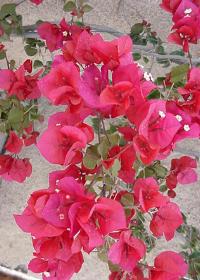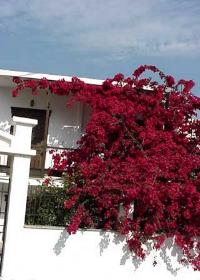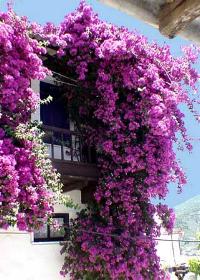|
Plants
for your home
(By Mary Efanti)
 Bougainvillea Bougainvillea
Description and Origin
Purple, red, white, lately orange and bi-colors as well . . . No one can think of a
Greek landscape in summer without the impressive bougainvillias adding color to
every spot, at house yards, or together with the white and blue colors of the
Greek islands. However, contrary to what we may think, bougainvillea is not a
Mediterranean plant but native to Brazil.
Cultivation
It does well in all soils and performs impressively even in large containers on a
balcony. However the soil must drain well because excessive water harms the
plant. The leaves show up first, when the weather starts to warm up in spring, and slowly the buds start to
form. Many impressive flowers appear at the end of thin stems, having a white stamen in their
centers. Flowers last a long time and in our temperate climate, blooming starts early in spring and lasts until the first cold
spells. Late in autumn, when the weather cools down, and after blooming has
ceased, its foliage turns yellow and drops. As a result, during the winter, your bougainvillea will look like a mess of
dry, dead stems.
Care
 A
beautiful, hardy plant, that does not need much in the way of everyday care. It is also resistant to insects and
disease, but you should check for insects as often as you do for other plants in your garden or
balcony, just in case. A
beautiful, hardy plant, that does not need much in the way of everyday care. It is also resistant to insects and
disease, but you should check for insects as often as you do for other plants in your garden or
balcony, just in case.
Being a tropical plant in origin, bougainvillea needs plenty of light. So plant it at a spot where it gets direct
sunlight. Keep in mind, that your bougainvillea will not bloom unless it gets enough direct
sunlight, at least 8 hours per day.
Water only when her leaves start to wither and do not over-water because either her leaves will turn yellow and
drop, or you will get lots of foliage and no flowers. Also, be careful when fertilizing because if you
over-fertilize you will still get a green plant with no flowers.
Bougainvillias hate low temperatures and harsh wind drafts. So, make sure to plant it near a
wall, train it on a trellis, or any spot that is protected from harsh wind and tie it
steadily. If you want it to gain height quickly, i.e. from your garden on to the rail of your
balcony, use a trellis or tie wire (make sure it has plastic around it) on your rail and tie its branches on
it. Do not tie the plant too tight because her branches break easily while they are still young and
green.
 If
you live in areas with extremely low temperatures in winter, it would be
advisable to cover your bougainvillea with plastic in order to prevent the plant
from freezing. Remember to open some holes on the plastic so that the moisture
evaporating from the plant does not freeze on it. If your bougainvillea is
damaged by frost and manages to survive, new growth will appear in spring, but
her development will be like starting all over again. If
you live in areas with extremely low temperatures in winter, it would be
advisable to cover your bougainvillea with plastic in order to prevent the plant
from freezing. Remember to open some holes on the plastic so that the moisture
evaporating from the plant does not freeze on it. If your bougainvillea is
damaged by frost and manages to survive, new growth will appear in spring, but
her development will be like starting all over again.
Bougainvillea is a plant that you do not have to prune but if you wish, you can
do so as there is nothing to be afraid of. You can prune at any time of the year,
as much as you want, but remember that new growth will develop only in spring
when the weather warms up a little. So, if you prune and do not see any new
growth, don’t worry. The only pruning that you must do is to cut off the thin
woody stems that remain on the plant after the flowers are gone.
Bougainvillea’s branches, through time, turn into wood, so when you decide to
train it on a trellis remember that you will not be able to change its location
in the future. So, choose a spot in which your bougainvillea will “reside”
permanently and grow, showering you with beautiful flowers for many years to
come.
Mary Efanti
[email protected]
|
